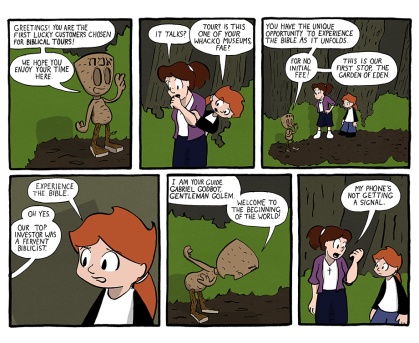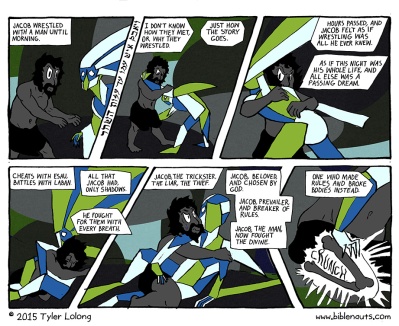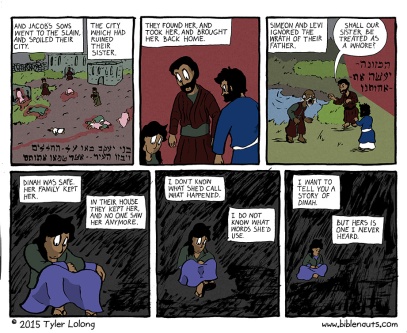by @TakeThatDarwin
Hey, Tyler. Thanks for agreeing to answer a few questions about Biblenauts, which gives me an excuse to talk about Biblenauts on my Twitter account, which I enjoy doing.
For the past year and change, you’ve written and drawn Biblenauts, a Monday-Wednesday-Friday webcomic that explores the Old Testament. Is this your first webcomic? How do you stick to your schedule so — ah ha ha — religiously? And how did you decide that a webcomic was the best means of exploring the Bible in this way?
I started doing comics in college, where I had a five-day- a-week strip in the student paper. It was awful and I loved it. That strip got me used to following a deadline pretty quick. After that I did a comic called Pomophobia for a couple years while suffering through grad school and developing Biblenauts. That comic is still at pomophobia.com, if anyone’s interested. Fae and Basie show up.
I love making comics, and I love the Bible, so combining the two just made sense. A ton of folks have adapted the Bible, including cartoonists, but I don’t know of too many adaptations that followed a newspaper-strip style, doing bits and pieces over time. I like the intimacy a comic strip brings, and how that intimacy contrasts with the bombast of the sword-and-sandal epic. I also love how comic strips can quickly switch between  storytelling and one-shots, which is useful when dealing with a collection like the Bible that’s made up of more than just stories.
storytelling and one-shots, which is useful when dealing with a collection like the Bible that’s made up of more than just stories.
The characters of Fae and Basie were prominent in the first few comics, but have since faded into the background and become a sort of Greek chorus, appearing only to deliver the occasional punchline or bit of editorializing. (Fae’s comment at the end of the Sodom and Gomorrah story was especially brilliant.) How much was their role intended to change from the beginning, and how much just sort of organically happened?
Biblenauts is inspired by (ripping off) Superbook, an anime that adapted the Bible for a Japanese audience. It featured two kids and a robot traveling to Bible times to learn lessons about genocide and the importance of cleaning your room. Originally I wanted to do a straight-up parody, with my present-day characters as the main focus, and had a whole prelude chapter written out. But then I realized I was sixteen pages in before I got to “in the beginning,” and I decided that maybe my Bible comic should focus on the Bible.
I really liked the characters, though, and their chorus function is very useful, so they stuck around. Currently they spend a lot of time in the background because the Bible characters steal the stage. When I hit later books like Judges, which has minimal characterization, Fae and Basie will have a bigger role to play.
One of the things you do remarkably well is highlight both the admirable and less-admirable aspects of various Biblical characters, thereby humanizing them and bringing them to life. Your interpretation of Jacob, for one, is clever but deceptive, almost Odysseus-like. How much of your characterization do you think is textually supported?
Do you think a first-time Bible reader would come away with similar impressions of these characters? Would a Bible scholar?
This question is complicated, because different traditions and different scholars disagree on how to interpret the text. I like to think I hew pretty close to the text, but the Bible is so intertwined with my identity that I can’t claim any sort of objectivity.
While I stand by my readings, they’re not meant to be scholarly. I pull mainly from the text, but also from pop culture, folklore, midrash, and scholarship. My version of Joseph is likely different from what most modern readers will take from the text, because I took it from extra-biblical traditions that depict Joseph as feminine. And sometimes I go with a particular translation just because it’s funny.
Your portrayal of angels is MEGA otherworldly. What influenced your decision to make them so different from the traditional dude-but-with-wings image?
In my mind, the best pop culture version of an angel I’ve come across is Madeline l’Engle’s A Wind in the Door, which features a cherubim made up of a pulsing mass of wings and eyes. I used to stare at that novel’s cover art. I like her take on angels because they resemble the otherworldly depictions you see in texts like Ezekiel. When that prophet approaches divinity, he has trouble describing what he sees. I wanted to approximate that.
In your earliest comics, the serpent in the Garden of Eden is a talking snake rather than, as people seem to automatically assume, Satan. How did so many people come to the conclusion that the serpent is Satan, and why did you avoid that reading? Are there any other instances you’d like to point out where you break ranks with modern-day Bible interpretations?
That interpretation really shows the power of tradition. The text never refers to the snake as anything other than a snake, but enough people made the connection with the Christian concept of the devil that we started to read him into the story. I felt that shoving  the devil in would add little to the story, so I left the snake a snake. Though Fae found a way to shove Jesus into that story, so maybe the whole thing is a wash.
the devil in would add little to the story, so I left the snake a snake. Though Fae found a way to shove Jesus into that story, so maybe the whole thing is a wash.
You warned your readers about the story of Dinah early on, and probably with good reason. It’s one of those stories that really highlights the difference in values between us and the authors of the Old Testament — while it’s a fascinating revenge story, it totally treats the rape victim as a MacGuffin who drops off the radar as soon as she’s set up the conflict between the male characters. Your thoughts?
Yeah, the true horror of that story, for me, is that no one asks Dinah what she thinks. She never gets to speak. If that story pisses anyone off, I highly recommend Anita Diamant’s The Red Tent, which goes through most of Genesis from Dinah’s perspective.
While your affection for the Bible as literature is obvious, I get the impression — pardon me for saying so — that the affection is kind of one-sided, and that you are probably not the audience the Bible’s authors intended thousands of years ago. What do you think?
I’m not an ancient Israelite, no. I doubt the Bible’s authors and editors would like me very much.
How do you feel about the people who maintain that they can draw meaningful lessons from a sola scriptura reading of the Bible without understanding the culture from which it came?
Depends on the lesson. Do you use the Bible to make the world a better place, and to bring you closer to God? Then go for it. Do you use the Bible to devalue other people, and justify hatred? Then we have a problem.
Anyone who claims they’re just following the Bible is lying, though. We all come to it from a tradition, even just by existing in the Western world. We all have biases which affect our reading. You have to examine how your view of the world colors your interpretation, and vice versa.
You started Biblenauts more than a year ago and have, at this point, made it most of the way through Genesis. What does the future hold for Biblenauts? Will you be skipping ahead at any point? Is the New Testament in the cards?
Well, Exodus is next, naturally. I plan to focus mainly on the narrative material, but the format of a comic strip lets me jump out of a story and play with whatever I want. I do want to put at least a little of every book of the Tanakh in the strip, but some may need to be peppered in with others. I doubt anyone would want a full year of just Psalms.
Thanks so much for your time, Tyler.
Thanks for the opportunity!